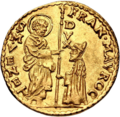History of coins in Italy
| History of Italy |
|---|
 |
|
|
| Part of a series on |
| Numismatics the study of currency |
|---|
 |
Despite the fact that the first Italian coinage systems were used in the
Since Italy has been for centuries divided into many
Antiquity
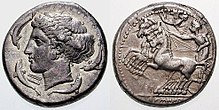

Despite the fact that the first Italian coinage systems were used in the Magna Graecia and Etruscan civilization, the Romans introduced a widespread currency throughout Italy. Unlike most modern coins, Roman coins had intrinsic value.[3]
The brief period of

The family of
their circulation (and perhaps their release) continued even after the conflict ended, contemporary and promiscuously with their republican models.


After the
The manufacture of coins in the Roman culture, dating from about the 4th century BC, significantly influenced later development of coin minting in Europe. The origin of the word "mint" is ascribed to the manufacture of silver coin at Rome in 269 BC near the temple of
While they contained precious metals, the value of a coin was higher than its precious metal content, so they were not bullion. Estimates of their value range from 1.6 to 2.85 times their metal content, thought to equal the purchasing power of 10 modern British Pound Sterling (US$15) at the beginning of the Roman Empire to around 18 Pound Sterling (US$29) by its end (comparing bread, wine and meat prices) and, over the same period, around one to three days' pay for a Legionnaire.[13]
Middle Ages and Renaissance
Italy has been influential at a coinage point of view: the medieval
Lombard coinage

The Lombard coinage refers to the autonomous productions of coins by the Lombards. It constitutes part of the coinage produced by Germanic peoples occupying the former territory of the Roman Empire during the Migration Period. All known Lombard coinage was produced after their settlement of Italy. The coinage originates from two distinct areas, in Langobardia Major between the last decades of the sixth century and 774, and in Langobardia Minor, in the duchy of Benevento, between approximately 680 and the end of the 9th century.
Only five hoards have been found which contain non-pseudo-imperial coinage of the Lombards. Of these, only two have been published in any detail.
- A hoard found at Ossi, Sardinia was described by Vincenzo Dessì in 1908.[14]
- A hoard found at Ilanz, Grisons was described by Fritz Jecklin in 1906,[15] and was further studied by Bernareggi in 1977.[16]
Florentine florin
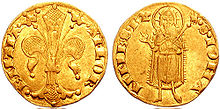
The

The fiorino d'oro (gold florin) was used in the Republic of Florence and was the first European gold coin struck in sufficient quantities since the 7th century to play a significant commercial role. The florin was recognised across large parts of Europe. The territorial usage of the lira and the florin often overlapped, where the lira was used for smaller transactions (wages, food purchases), the florin was for larger transactions such as those used in dowries, international trade or for tax-related matters.[20]
The Florentine florin is of the most used coinage types in European history and one of the most important coins in Western history.
Venetian sequin

The sequin (Venetian and Italian: zecchino [dzekˈkiːno]) is a gold coin minted by the Republic of Venice from the 13th century onwards. The design of the Venetian sequin remained unchanged for over 500 years, from its introduction in 1284 to the fall of the Republic of Venice in 1797, making it the most prestigious gold coin in circulation in the commercial centers of the Mediterranean Sea.[2] No other coin design has ever been produced over such a long historical period.
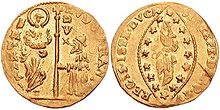
The reverse bears a motto in Latin hexameter: Sit tibi, Christe, datus // quem tū regis, iste ducātus ("Christ, let this duchy that you rule be given to you").[23] On the obverse there is Mark the Evangelist, patron saint of Venice, who is depicted with a beard and halo, is facing to the right and is wrapped in a large cloak while holding the Gospel with his left hand. With his right hand the saint offers a banner to the Doge of Venice who is kneeling to the left and holding the staff with both hands. The Doge wears a rich fur-trimmed cloak and the ducal cap, under the flag facing to the right the vertical writing "dux", around it "s·m·venet" and the name of the Doge.[23]
The quality of the minting is superior to all contemporary coins and this shows that the artists of the Venice Mint had already reached a high level of taste and refinement of design at the time.
Venetian grosso
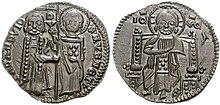
The Venetian grosso (plural grossi) is a silver coin first introduced in the Republic of Venice in 1193 under doge Enrico Dandolo. It originally weighed 2.18 grams, was composed of 98.5% pure silver, and was valued at 26 denarii. Its name is from the same root as groschen and the English groat, all deriving ultimately from the denaro grosso ("large penny"). Its value was allowed to float relative to other Venetian coins until it was pegged to 4 soldini in 1332, incidentally the year the soldino was introduced. In 1332, 1 grosso was the equivalent of 4 soldini, or 48 denarii.
The earliest surviving account of Enrico Dandolo's introduction of the Venetian grosso associates it with the outfitting of the Fourth Crusade in 1202[25] and tradition makes the need to pay for the ships which transported the crusaders the cause of the grosso's introduction. Even though coinage of the grosso might have begun a few years earlier, the influx of silver used to pay for the crusaders' ships led to its first large scale mintage. The coin had 2.2 grams of 98.5% fine silver, the purest medieval metallurgy could make.[26] It was initially called a ducatus argenti since Venice was a duchy, but is more widely known as a grosso or matapano, a Muslim term referring to the seated figure on its reverse.[27]
Venetian lira

The Venetian lira (plural lire) was the distinct currency of the Republic of Venice until 1848, when it was replaced by the Italian lira. It originated from the Carolingian monetary system used in much of Western Europe since the 8th century CE, with the lira subdivided into 20 soldi, each of 12 denari.
From its initial value of 305.94 g fine silver, the Venetian lira had depreciated so much in value over its 1,000-year lifetime that this original unit was referred to from 1200 CE as the lira piccola (small lira) in comparison to larger units of the same name.[28] The denaro or piccolo worth 1⁄240th a lira was the only coin produced between 800-1200 CE. Initially weighing 1.7 g fine silver, it depreciated over the centuries until it contained only 0.08 g fine silver by 1200 CE.
The various currency systems of Italy became of less importance to European trade after the Age of Discovery in the 16th century; nonetheless Venice continued to issue new coins. The scudo d'argento of 30.1 g fine silver was introduced in 1578 for 7 lire, rising to 12.4 lire by 1739. The tollero of 23.4 g fine silver was issued in 1797 for 10 lire.
The Venetian lira piccola was supplanted in the 19th century by the Italian lira of the
Genoese lira


The Genoese lira (Italian: Lira genovese) was the currency of the Republic of Genoa until 1797. The mint in the Republic of Genoa began its production around 1138,[29] with coins introduced in line with similar versions issued in the rest of Europe, as follows:
- The silver denaro in 1138, containing 1.06 grams of 1⁄3 fine silver (or 84.8 g fine silver in a lira);
- The silver grossoin 1172 worth 4 denari, of 1.4 g of 23⁄24 fine silver (or 80.5 g fine silver in a lira);
- The gold Genovino d'oro in 1252, at about the same time as the Florentine florin; of 3.5 g fine gold, and worth 1⁄2 lira (each lira worth either 7 g fine gold or 70 g fine silver);
- The testone or 1-lira coin before 1500, containing about 13 g of 23⁄24 fine silver (or 12.5g fine). It was the highest-valued Italian coin unit in the end of the 15th century.[30]
Genoese currency became important in the 16th century during the Golden age of Genoese banking, with the Spanish Empire funnelling its massive wealth from Spanish America through the Bank of Saint George. With the decline in the fortunes of the Genoese banks and the Spanish Empire in the 17th century, however, the Genoese lira also depreciated substantially. The silver scudo's value increased to 6.5 lire in 1646, 7.4 lire in 1671, and 8.74 lire just before the Austrian occupation of Genoa in 1746.[31]
Papal States florin

The
Papal States Giulio

The
In 1540
The last coin minted with this name was the silver giulio struck by
Papal States Paolo

The
At the time of the arrival of the
Lazian baiocco
The
It underwent numerous other variations of material losing more and more silver and becoming more and more low alloy, so much so that it was indicated with the derogatory "Baiocchella" during the period of Sixtus V from 1585 to 1590.[35] It disappeared after the unification of Italy between 1861 and 1870, when the Italian lira was introduced
Neapolitan cavallo

The cavallo was a copper coin of southern Italy in the Renaissance. It was minted for the first time by King Ferdinand I of Naples in 1472.[36] It gained its name from the figure of a horse on the reverse.
The name later was used for coins of the same values but with different types such as that minted by
The cavallo was mint again shortly under
Anconetan agontano

The agontano was the currency used by the Italian Maritime Republic of Ancona from the 12th to the 16th centuries during its golden age. It was a large silver coin of 18-22mm in diameter and a weight of 2.04-2.42 grams, of roughly equivalent value to the Milanese Soldo. The first reports of Ancona's medieval coinage begin in the 12th century when the independence of the city grew and it began to mint coinage without Imperial or papal oversight.[37]
The coin, also called "Grosso Agontano", was a great success and its type was imitated in other cities of Marche and also in Emilia-Romagna, Tuscany, Lazio and Abruzzo. For example, coins of Massa Marittima,[38] Ravenna, Rimini, Volterra,[39] Pesaro and Ferrara.[40] show a marked influence from Ancona.
Milanese soldo

The soldo was an Italian medieval silver coin, issued for the first time in the late 12th century at Milan by Emperor Henry VI.[41] The name derives from the late Roman coin solidus.[42]
It quickly became widespread in Italy, where it was coined in
Neapolitan gigliato

The
Charles II of Anjou's silver gigliato was the same diameter as the dominant silver coin of its time, the French gros tournois, or as the grosso rinforzato being struck by the Roman Senate, i.e. 24 m.m.. It contained 4.01 grams of .929 fine silver, or 3.73 grams of pure silver. Its types were more typical of French gold coins, especially Philip the Fair's petit royal d’or, than Italian silver coins.[46]
Bolognese bolognino

The Bolognino was a coin minted in Bologna and other cities of medieval Italy from the late 12th century to the 17th century.
The coin originated in 1191, when emperor Henry VI granted Bologna the right to mint a silver denaro. In 1236 this unit was rechristened Bolognino piccolo (Small Bolognino) when the Bolognino grosso (Big Bolognino) was introduced, with the value of a 12 soldi. It weighed 9 carats.[47]
The grosso was adopted in other Italian communes and cities, such as Ravenna and Rimini and copied by other mints, such as those of Lucca, Rome and other cities in Abruzzo and Marche. The value changed depending from the current political and economic situation.
The bolognino was no longer struck starting from the 18th century. Multiples up to 100 bolognini continued to exist, however.
A golden bolognino, introduced in 1380, had the value of 30 silver bolognini (same title and weight of the Papal
Sicilian pierreale

The pierreale (plural pierreali, i.e. "reale of Peter") was a silver coin minted by the Kingdom of Sicily between the reigns of Peter I (1282–1285) and Ferdinand II (1479–1516). It was equivalent in weight and fineness to the Neapolitan carlino and was sometimes called a carlino.
It carried on the obverse the
Gold pierreali equivalent to ten silver ones were minted under Peter I, but only rarely thereafter. Half-pierreali and quarter-pierreali were minted between 1377 and 1410 and again during the reign of John (1458–1479).[48]
Sicilian augustalis
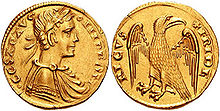
An
The augustalis bore a
Modern era
The early modern Italian coins were very similar in style to French francs, especially in decimals, since it was ruled by the country in the
Papal States scudo
The
Between 1798 and 1799, the
In 1808, the Papal States were annexed by France, and
In 1866, the scudo was replaced by the
Parman lira

The
After the re-establishment of Parman independence, the Parman currency system was introduced in 1815.[55] Also called the lira, it was subdivided into 20 soldi or 100 centesimi. However, this lira was equal to the French franc and the Sardinian lira, and it circulated alongside the latter. It weighed 5 grams, and had a purity of 9/10 of silver. Since 1861, Parma has used the equivalent Italian lira.
Sardinian scudo

The Sardinian scudo (plural: scudi) was the currency of the Kingdom of Sardinia from 1720 to 1816. It was subdivided into 2½ lire (singular: lira), each of 4 reales, 20 soldi, 120 cagliarese or 240 denari. The doppietta was worth 2 scudi. It was replaced by the Sardinian lira.
In the late 18th century, coins circulated in denominations of 1 and 3 cagliarese, 1 soldo, ½ and 1 reale, ¼, ½ and 1 scudo, 1, 2½ and 5 doppietta. The cagliarese denominations were struck in copper, the soldo and reale in billon, the scudo in silver and the doppietta in gold.[56]
Two Sicilies oncia

In southern Italy, the
In the medieval kingdoms of Naples and Sicily, one oncia was equivalent to 30 tarì, 600 grani and 3600 denari (pennies). Conventionally, a sum of money is indicated by numbers of oncie, tarì, grani and denari separated by full stops, thus 2.2.15.1 indicates 2 oncie, two tarì, 15 grani and 1 denaro. Although the oncia was never minted in the Middle Ages, it was the basic unit of account. The lesser denominations were minted, as was the ducat (six of which equalled an oncia) and the carlino (60 to the oncia).[57][58] Frederick II introduced the augustalis, which was a quarter of an oncia.[59]
Two Sicilies tornesel

The tornesel, tornesol, or tornese was a silver coin of Europe in the Late Middle Ages and the early modern era. It took its name from the denier tournois, the denier of Tours.
His descriptions were based on the conversion of 1 bezant = 20 groats = 133+1/3 tornesel.[60] The tornese was a subunit of the Neapolitan, Sicilian, and Two Sicilies ducats.
Luccan lira

The
The Luccan lira contained less silver than the
Piedmontese scudo

The Piedmontese scudo (plural: scudi) was the currency of the Piedmont and the other mainland parts of the Savoyard Kingdom of Sardinia from 1755 to 1816. It was subdivided into 6 lire (singular: lira), each of 20 soldi or 240 denari. The doppia was worth 2 scudi. During the Subalpine Republic and French occupation (1800–1814), the French franc circulated, supplemented by a small number of locally produced coins. The scudo was replaced by the Sardinian lira.
In the late 18th century, copper 2 denari, billon ½, 1, 2½ and 7½ soldi, silver ¼, ½ and 1 scudo, and gold ¼, ½, 1, and 2½ doppia coins circulated. In the 1790s, copper 1 and 5 soldi, and billon 10, 15 and 20 soldi were added.[62] The Piedmont Republic issued silver ¼ and ½ scudo in 1799. This was followed in 1800 by bronze 2 soldi struck in the name of the "Piedmont Nation" (Nazione Piemontese).
Tuscan lira

The
In 1803 the Tuscan lira was equivalent to 0.84
Sicilian piastra

The Sicilian piastra was the distinct currency of the Kingdom of Sicily until 1815. In order to distinguish it from the piastra issued on the mainland Kingdom of Sicily (also known as the Kingdom of Naples), it is referred to as the "Sicilian piastra" as opposed to the "Neapolitan piastra". These two piastra were equal, but were subdivided differently. The Sicilian piastra was subdivided into 12 tarì, each of 20 grana or 120 piccoli. The oncia was worth 30 tarì (2½ piastra).
In 1815, a single piastra currency was introduced for the
, the Sicilian money system can be readily extracted. It was:-- 1 onze = 30 Tari, 1 Taro = 20 Grani, 1 Grano = 6 piccioli.
On both of these historic documents, the denomination piastra was not used. A Sicilian coin commonly available for sale today is the 120 grana silver piece, weighing an ounce. It is called, in the supplementary description of this silver piece, one piastre. However, in 1823 George Crabb, in his Universal Technological Dictionary Volume 2, in addition to supporting the above relative values of onze, tari and grani in accounting, lists 120 grani as equivalent to one florino. Crabb also lists the ponto, the carlino, the ducat and the scudo or crown and their equivalence to the grano, however no mention of the piastre.[64]
Neapolitan piastra

The Neapolitan piastra was the most common silver coin of the Kingdom of Naples. In order to distinguish it from the piastra issued on the island of Sicily, it is referred to as the "Neapolitan piastra" as opposed to the "Sicilian piastra".
These two piastra were equal but were subdivided differently. The Neapolitan piastra was divided into 120 grana (singular: grano), each of 2 tornesi (singular: tornese) or 12 cavalli (singular: cavallo). There were also the carlino worth 10 grana and the ducato worth 100 grana.[65]
In 1812, the
Two Sicilies piastra
The
The piastra was the unofficial name of the biggest silver coin, which had a value of 120 grana. When the Italian lira replaced the coinage of the House of Bourbon in 1861, a rate of 1 piastra = 5.1 lire was established.
Neapolitan lira

The Neapolitan lira was the currency of the mainland part of the Kingdom of the Two Sicilies, known as the Kingdom of Naples, between 1812 and 1815.[68] The currency was issued by Joachim Murat, who claimed the title of "King of the Two Sicilies" but only controlled the mainland part of the kingdom. Consequently, the currency is referred to as the "Neapolitan lira". It was subdivided into 100 centesimi (singular: centesimo) and was equal to the Italian lira and French franc. It replaced the piastra, which circulated again following the restoration of Bourbon rule.
Coins were issued in denominations of 3, 5 and 10 centesimi, ½, 1, 2, 5, 20 and 40 lire. The centesimi denominations were struck in bronze, the lire coins up to 5 lire were in silver and the higher denominations were in gold. All the coins bore the head of name Joachim Murat and his adopted Italian name, "Gioacchino Napoleone".
Sardinian lira

The Sardinian lira was the currency of the Kingdom of Sardinia between August 6, 1816, and March 17, 1861. It was subdivided into 100 centesimi (singular centesimo) and was equal in value to the French franc (4.5 grams of silver), which had previously been used as the currency of the Kingdom of Sardinia, having replaced the Piedmontese scudo by 1801.
Since the Sardinian lira was little more than another version of the French franc, it could circulate also in
On each coin, the ruling monarch was styled in
Roman scudo

The
In addition to issues for the Papal States as a whole, the currency was also issued by many of the individual municipalities. In the late 18th century, this included issues from
Tuscan florin

The Tuscan florin was the currency of Tuscany between 1826 and 1859. It was subdivided into 100 quattrini (singular: quattrino), with an additional denomination called the paolo, worth 40 quattrini, in circulation.
During the
In 1847, Tuscany absorbed Lucca and the Tuscan florin replaced the Luccan lira at a rate of 1 Tuscan florin = 2 lire. After a brief revolutionary coinage, the Tuscan florin was replaced in 1859 by a provisional currency denominated in "Italian lira", equal to the Sardinian lira, with 1 Tuscan florin = 1.4 Italian lire.
Lombardo-Venetian lira
The Lombardo-Venetian lira (or lira; plural: lire) was the currency of the Kingdom of Lombardy–Venetia between 1822 and 1861. The lira was made of 4.33 grams of silver (with 9/10 of purity). Six lire were equal to the scudo which was equivalent to the Austrian Conventionsthaler, hence they had no relation to the former currencies the Venetian lira and the Milanese scudo. The lira was divided into 100 centesimi (cents). Coins were minted in Milan and Venice.[72]
During the revolutions of 1848, the Lombard Provisional Government briefly suspended the production of the lira and minted instead a special 5 Italian lire coin. After the revolutions and the restoration of the Austrian monetary standard, copper coins were reduced in weight. For political purposes the name on these coins (the most popular in circulation) was changed from Kingdom of Lombardy–Venetia to the Austrian Empire.
Lombardy-Venetia florin
The
The only coins issued specifically for Venetia were copper 1⁄2 and 1 soldo pieces. The name soldo was chosen due to the equivalence of the predecimal kreutzer and soldo, both worth 1⁄120 of a Conventionsthaler.
The florin was replaced by the Italian lira at the rate of 1 lira = 40+1⁄2 soldi (1 florin = 2.469 lire). This rate corresponded to the comparative silver contents of the lira and florin coins.
Papal lira

The Papal lira was the currency of the Papal States between 1866 and 1870. It was subdivided into 20 soldi, each of 5 centesimi. In 1866 Pope Pius IX, whose temporal domain had been reduced to only the province of Latium, decided to join the Latin Monetary Union.[74] A new currency, the lira, was introduced with the same value of the French franc and the Italian lira.
It replaced the scudo at a rate of 5.375 lire = 1 scudo. The lira was subdivided into 100 centesimi and, differently from the other currencies of the union, into 20 soldi. However, all denomination in soldo had an equivalence in cents. However, after joining the Union, the Pope's treasurer, Giacomo Antonelli, devalued the purity of the Papal silver coins from 900/1000 to 835/1000.[75] With the annexation of the Papal States to Italy in 1870, the Papal lira was replaced by the Italian lira at par.
Contemporary period
Since
Italian lira
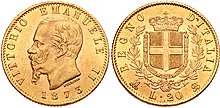
The
The term originates from libra, the largest unit of the Carolingian monetary system used in Western Europe and elsewhere from the 8th to the 20th century.[6] The Carolingian system is the origin of the French livre tournois (predecessor of the franc), the Italian lira, and the pound unit of sterling and related currencies.
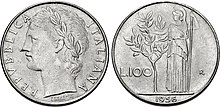



There was no standard
On 24 August 1862 the decree was issued which established the decommissioning of all other coins circulating in the various pre-unification states by the end of the year.
In 1866, due to the growth of public spending, partly due to the costs of the Third Italian War of Independence, the inconvertible paper money system was established, which lasted until 1881 (with effect from 1883). However, already at the end of 1887 the convertibility of the notes had to be effectively suspended, even without openly declaring it. In 1893, the Banca Romana was put into liquidation, hit by a serious scandal, and the Bank of Italy was created, with a gold backing of at least 40% of the lire in circulation.
King
World War I broke the Latin Monetary Union and resulted in prices rising severalfold in Italy. Inflation was curbed somewhat by
After the war, the Roman mint first issued the first 1, 2, 5 and 10 lira coins (6 September 1946). They were officially set up on 21 December of the same year and were used up to 1953–4.
In December 1973 some of the major
The lira was the official unit of currency in Italy until 1 January 1999, when it was replaced by the euro (euro coins and notes were not introduced until 2002). Old lira denominated currency ceased to be legal tender on 28 February 2002. The conversion rate is 1,936.27 lire to the euro.[97] All lira banknotes in use immediately before the introduction of the euro, as all post WW2 coins, were still exchangeable for euros in all branches of the Bank of Italy until 29 February 2012.
Italian euro coins
The euro officially began circulating in Italy on 1 January 2002 (even though the creation of Italian lira coins was suspended in 1999).[93] Italian euro coins have a design unique to each denomination, though there are many themes of works by one of the most renowned and famous Italian artists and painters. In particular, on the reverse of Italian euro coins are depicted:[98]
- Andria
- 2 euro cent coin: Mole Antonelliana, a tower symbolising the city of Turin
- Roman amphitheater
- The Birth of Venus by Sandro Botticelli
- 20 euro cent coin: Futurist sculpture Unique Forms of Continuity in Space by Umberto Boccioni
- 50 euro cent coin: Equestrian Statue of Marcus Aurelius
- 1 euro coin: Vitruvian Man, a drawing by Leonardo da Vinci
- 2 euro coin: Dante Alighieri, an Italian poet, writer and philosopher, considered the father of the Italian language
Each coin is designed by a different designer, from the 1 cent to the 2 euro coin they are: Eugenio Driutti, Luciana De Simoni, Ettore Lorenzo Frapiccini, Claudia Momoni, Maria Angela Cassol, Roberto Mauri, Laura Cretara and Maria Carmela Colaneri. All designs feature the

The choice of the design of the coins was left to the Italian public by means of a television broadcast where alternative designs were presented, letting the people vote by calling a certain telephone number.
As in Finland and the Netherlands, the minting of 1 and 2 cent coins was suspended in Italy from 1 January 2018. However, coins in circulation have legal value.[102] The cost of creating a one-cent euro coin exceeded its face value. This amounted, in fact, to 4.5 cents. Even for the production of the two cent coin, a sum greater than its value was spent: 5.2 cents.[103]
In 1999, following a technical error, 1,179,335 pieces of 20 cents were minted with the 1999 millage, instead of the 2002 millage foreseen by the issuing decree. The
See also
- Coinage of the Republic of Siena
- Coinage of the Republic of Venice
- Coins of the Italian lira
- Economic history of Italy
- Etruscan coins
- Greek coinage of Italy and Sicily
- Italian euro coins
- Roman currency
References
- ^ a b c "IL FIORINO DI FIRENZE, STORIA DEL "DOLLARO DEL MEDIOEVO"" (in Italian). Retrieved 4 October 2023.
- ^ a b c Nicolò Papadopoli Aldobrandini (2009). Le monete di Venezia descritte ed illustrate da Nicolò Papadopoli Aldobrandini (in Italian). "Progetto Gutenberg Piero Vianelli. p. 136.
- ^ a b "IL VALORE DELLE MONETE ROMANE" (in Italian). Retrieved 4 October 2023.
- ^ a b "Italian coins". ilmarengo.com. Archived from the original on 8 August 2017. Retrieved 14 April 2018.
- ^ "Forex Trading Information, Learn About Forex Trading". forex-guide.net. Archived from the original on 26 September 2018. Retrieved 14 April 2018.
- ^ a b The last country to abandon the Carolingian system was Nigeria in 1973, when the pound was replaced by the naira.
- ^ "Taranto" (in Italian). Retrieved 4 October 2023.
- ^ "L'aes grave di Volterra" (in Italian). Retrieved 4 October 2023.
- ^ Alberto Campana, La monetazione degli insorti italici durante la Guerra sociale (91-87 a.C.), Apparuti Edizioni, 1987, p. 37.
- ^ "Blanchard and Company, Inc. - The Twelve Caesars". Retrieved 8 February 2017.
- ^ Jean Lafaurie and Cécile Morrisson, 'La pénétration des monnaies byzantines en Gaule mérovingienne et visigotique du VIe au VIIIe siècle', Revue numismatique, 6th series, vol. 29, 1987, p. 40.
- ^ "Moneta, Giunone e Memoria" (in Italian). Retrieved 4 October 2023.
- ^ Buying Power of Roman Coins Archived 10 February 2013 at the Wayback Machine
- ^ Vincenzo Dessì, "I tremissi longobardi a proposito di un piccolo ripostiglio di monete d'oro di Liutprando, rinvenuto presso il villaggio di Ossi (Sassari)", "RIN 21 (1908), pagg. 295-311". Retrieved 11 September 2009. Ristampato in Gli scritti di numismatica (Sassari 1970), pagg. 225-244.
- ^ Fritz Jecklin, "Der langobardisch-karolingische Münzfund bei Ilanz", MBNG (Mitteilungen der Bayerischen Numismatischen Gesellschaft) 25 (1906-07) pagg. 28-79.
- ^ Ernesto Bernareggi, "I tremissi longobardi e carolingi del ripostiglio di Ilanz nei Grigioni", Quaderni ticinesi di numismatica..., 6 (1977) pagg. 341-364.
- ^ See the Ricordanze di S. Maria di Cafaggio, which mentions florins being used in the year MCCL (1250).
- Leo S. Olschki Editore. p. 66.
- ISBN 978-88-7402-665-4.
- ^ ISBN 978-1-78669-151-4.
- ^ Horner, Susan; Horner, Joanna B. (1884). Walks in Florence and Its Environs. Vol. 2. Smith. p. 125.
- )
- ^ Accademia Nazionale dei Lincei. p. 46. Retrieved 23 November 2020..
- ISBN 978-88-6448-039-8.
- ^ Alan M. Stahl, Zecca the mint of Venice in the Middle Ages, page 17
- ^ Thomas F. Madden, Enrico Dandolo and The Rise of Venice, page 110
- ^ Philip Grierson, The Coins of Medieval Europe, page 107.
- ^ Shaw, William Arthur (1896). "The History of Currency, 1252 to 1894".
- ^ Desimoni, Cornelio. Tavole Descrittive Delle Monete Della Zecca Di Genova Dal 1139-1814 (in Italian). Nabu Press.
- ^ M. Cipolla, Carlo. Economic History of World Population. Trophy Pr; 7 edition.
- ^ Serra, Girolamo. Discorso sulle monete di Genova recitato dal Signor Girolamo Serra rettore dell'Università all'Accademia delle scienze, lettere ed arti, nell'adunanza del dì 15 luglio 1810 (in Italian).
- ^ a b c
 This article incorporates text from a publication now in the public domain: Herbermann, Charles, ed. (1913). "Papal Mint". Catholic Encyclopedia. New York: Robert Appleton Company.
This article incorporates text from a publication now in the public domain: Herbermann, Charles, ed. (1913). "Papal Mint". Catholic Encyclopedia. New York: Robert Appleton Company.
- ^ a b c d e f g Edoardo Martinori (1915). La moneta: vocabolario generale (in Italian). Istituto italiano di numismatica. Retrieved 20 March 2023.
- ^ "Paolo". Treccani (in Italian).
- ^ "Baiocco Coin and ½ Half Baiocco | History and Value | Moneterare.net". Monete Rare. Retrieved 1 October 2020.
- ^ Arthur Sambon (1891). "I "Cavalli" di Ferdinando I d'Aragona, re di Napoli". Rivista italiana di numismatica (in Italian). IV: 327.
- ISBN 978-88-7663-451-2
- ^ Massimo Sozzi, L'Agontano di Massa di Maremma, in "L'Agontano. Una moneta d'argento per l'Italia medievale", edited by Lucia Travaini, Atti del Convegno di Trevi, 11-12 ottobre 2001, Perugia, Centro Stampa della Regione Umbria, 2003, pp. 111-140.
- ^ Voce sull'agontano nell'Enciclopedia Treccani
- ^ Voce Agontano sull'enciclopedia Sapere.it
- ISBN 978-0-19-870474-4.
- ^ Soldo. merriam-webster.com
- ISBN 978-1-135-94880-1.
- ^ European and Islamic trade in the early Ottoman state by Kate Fleet p.15
- ^ Catalogue of the Byzantine Coins by Dumbarton Oaks, Alfred Raymond Bellinger, Philip Grierson, Whittemore Collection (Fogg Art Museum) p.33
- ISBN 978-0521582315.
- ^ "Monete di Bologna" (in Italian). Retrieved 6 October 2023.
- ^ a b Philip Grierson and Lucia Travaini, Medieval European Coinage, Volume 14: Italy (III): South Italy, Sicily, Sardinia (Cambridge: Cambridge University Press, 1998), pp. 257–258.
- ISBN 978-0-521-58231-5.
- ISBN 978-0-19-508040-7.
The augustalis continued to be struck in the regno throughout the rest of the reign, and was even continued by later kings.
- ISBN 978-0-521-58231-5.
Sambon and others have supposed that augustales in Frederick's name continued to be issued [by his successors] down to 1266, which is possible but unsupported by positive evidence.
- ^ ISBN 978-0-521-58231-5.
- ^ a b c Augustale at the Encyclopædia Britannica (2008). Retrieved 7 October 2008.
- ^ Pinchera, S (a cura di) (1957). Monete e zecche nello stato pontificio dalla restaurazione al 1870 [Coins and mints in the papal state from the restoration to 1870]. Archivio economico dell’unificazione italiana. Vol. V, fasc. 3. Roma.
{{cite book}}: CS1 maint: location missing publisher (link) (cited in Rossi, Marinella (2013). La borsa di Roma dal 1847 al 1860 [The Rome Stock Exchange from 1847 to 1860] (PDF) (Thesis) (in Italian). Tesionline. p. 1. Archived (PDF) from the original on 27 September 2007. Retrieved 4 February 2010. (first degree thesis)) - ^ "Cronologia" (in Italian). Retrieved 6 October 2023.
- ISBN 0873410203.
- ^ Eleni Sakellariou, Southern Italy in the Late Middle Ages: Demographic, Institutional and Economic Change in the Kingdom of Naples, c.1440–c.1530 (Brill, 2012), p. 492.
- ^ Stephan R. Epstein, An Island for Itself: Economic Development and Social Change in Late Medieval Sicily (Cambridge University Press, 1992), p. xii.
- ^ Donald Matthew, The Norman Kingdom of Sicily (Cambridge University Press, 1992), p. xi.
- ^ ISBN 1603036156)
- ISBN 0873411501.
- ^ Salvatore Celli. "numispedia". numispedia.it (in Italian). Retrieved 20 April 2021.
- ^ Browne, William Alfred (1872). The Merchants' Handbook (Second ed.). London: Edward Stanford. pp. 46–50.
- ^ Crabb, George (1823). Universal Technological Dictionary: Or, Familiar Explanations of the Terms Used in All Arts and Sciences. Vol. 2. Baldwin, Cradock, and Joy. Retrieved 15 January 2021.
- ^ "VALORE CORRENTE DELLE MONETE DEL REGNO DELLE DUE SICILIE" (in Italian). Retrieved 6 October 2023.
- ^ A Handbook for Travellers in Southern Italy (1868)
- ^ A Handbook for Travellers in Southern Italy (1868)
- ^ Lodovico Bianchini (1835). Della storia delle finanze del Regno di Napoli (in Italian). Vol. 3. Tipografia Flautina. p. 862.[ISBN unspecified]
- ^ "MONETE CIRCOLANTI LIRA SARDA E ITALIANA DA METÁ 1800 SINO AL 1900 E NOMI IN MAMOIADINO" (PDF) (in Italian). Retrieved 6 October 2023.
- ^ il mercato borsistico romano (PDF) (Thesis) (in Italian).
- ^ This fact was quite obvious, because the pound was equivalent to 240 denari or 60 quattrini, while the Tuscan florin was equivalent to 100 quattrini or 400 denari.
- ISBN 978-88-89805-18-3.
- ^ Rivista italiana di Numismatica (PDF) (in Italian). Vol. 6. Società Numismatica Italiana. 1958. p. 87.
- ISBN 978-88-88894-03-4.
- ^ Pinchera, S (a cura di) (1957). Monete e zecche nello stato pontificio dalla restaurazione al 1870 [Coins and mints in the papal state from the restoration to 1870]. Archivio economico dell’unificazione italiana. Vol. V, fasc. 3. Roma.
{{cite book}}: CS1 maint: location missing publisher (link) (cited in Rossi, Marinella (2013). La borsa di Roma dal 1847 al 1860 [The Rome Stock Exchange from 1847 to 1860] (PDF) (Thesis) (in Italian). Tesionline. p. 1. (first degree thesis)) - ISBN 9788836511488. Retrieved 11 May 2019.
- ^ "Banca d'Italia Annual Report for 1982 - page 187" (PDF). bancaditalia.it. 31 May 1983. Retrieved 20 June 2022.
- ^ "A miniassegni issued by the Banca Popolare di Milano using "LIT." as the currency sign". 20 June 2019. Archived from the original on 6 December 2022. Retrieved 20 June 2022.
- ^ "A cheque issued by the Cassa Rurale ed Artigiana di Gaudiano di Lavello using a script version of "Lit."". 30 August 2015. Archived from the original on 6 December 2022. Retrieved 20 June 2022.
- ^ "Italy". CIA World Factbook 1990 - page 178. 1 April 1990. Retrieved 21 June 2022.
- ^ "1933 Registration Form of the Reale Automobile Club d'Italia prominently displaying "£50'000" in handwriting". Archived from the original on 6 December 2022. Retrieved 20 June 2022.
- ^ "An old price display sign in use in Sicily marked with both the lira and euro signs". Archived from the original on 6 December 2022. Retrieved 20 June 2022.
- ^ "Category:Coins of the Kingdom of Italy by year".
- ^ "Category:Coins of the Italian Republic by year".
- ISBN 978-8883420146.
- ISBN 978-8883420146.
- ^ "REGIO DECRETO 17 luglio 1861, n. 123" (in Italian). Retrieved 7 October 2023.
- ^ "LEGGE 24 agosto 1862, n. 788" (in Italian). Retrieved 7 October 2023.
- ^ "Poesie e Prose in dialetto". dialettando.com. Archived from the original on 2 July 2019. Retrieved 14 April 2018.
- ^ Storia del CNI
- ^ La collezione numismatica di Vittorio Emanuele III di Savoia
- ISBN 0-415-24989-9. p. 77.
- ^ a b "Italian Republic coins". ilmarengo.com. Archived from the original on 2 May 2015. Retrieved 14 April 2018.
- ^ "Fondo Monetario Internazionale – Ministero degli Affari Esteri e della Cooperazione Internazionale" (in Italian). Retrieved 4 January 2022.
- ISBN 978-8883420146.
- ISBN 978-8883420146.
- ^ "Ultimalira: Storia della Lira". Archived from the original on 15 May 2007. Retrieved 4 February 2010.
- ^ "Cos'è raffigurato sulle monete italiane?" (in Italian). Retrieved 6 October 2023.
- ^ "Buy the Italian euro coins". Archived from the original on 10 January 2010. Retrieved 4 February 2010.
- ^ Archivio RAI Archived 2011-11-17 at the Wayback Machine
- ^ "Scoppia la febbre dell'Euro". 9 February 1998. Retrieved 11 October 2013.
- ^ "Addio monete da 1 e 2 centesimi, sospeso il conio. Cosa cambia" (in Italian). Retrieved 6 September 2022.
- ^ "La Camera vota: addio alle monetine". Archived from the original on 8 May 2014. Retrieved 7 May 2014.
- ^ "20 centesimi di Euro" (in Italian). Retrieved 6 September 2022.
- ^ "Ecco la moneta da 1 centesimo che vale 2500 euro" (in Italian). Retrieved 6 September 2022.



